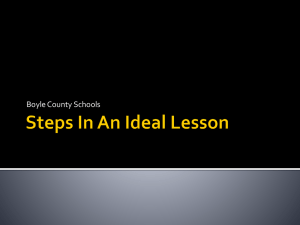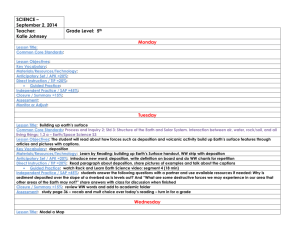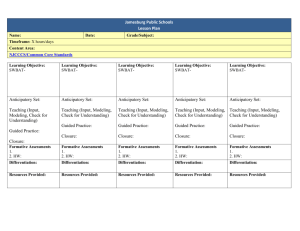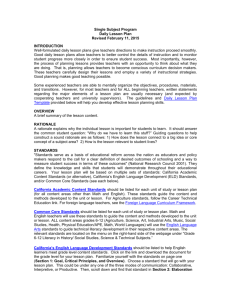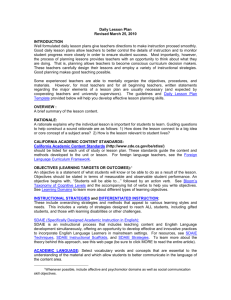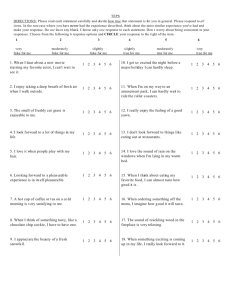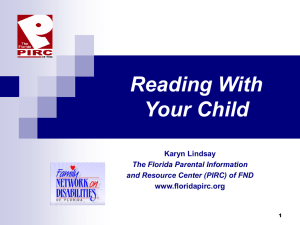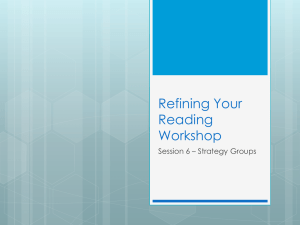Lesson Plan: Objectives, Instruction, & Practice
advertisement
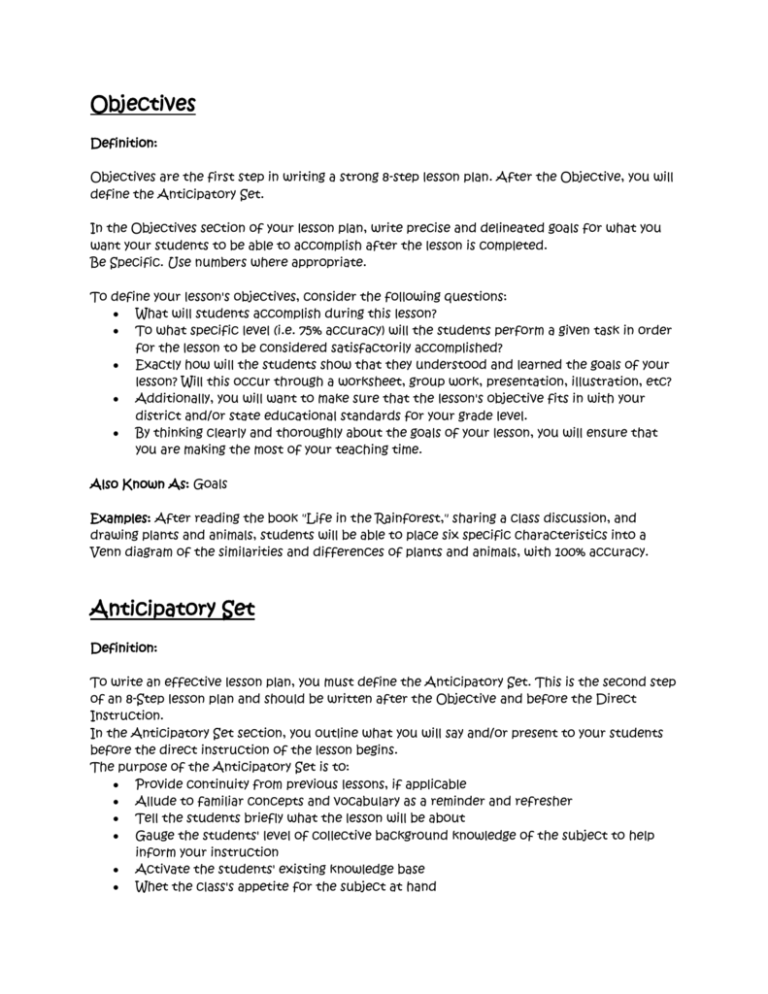
Objectives Definition: Objectives are the first step in writing a strong 8-step lesson plan. After the Objective, you will define the Anticipatory Set. In the Objectives section of your lesson plan, write precise and delineated goals for what you want your students to be able to accomplish after the lesson is completed. Be Specific. Use numbers where appropriate. To define your lesson's objectives, consider the following questions: What will students accomplish during this lesson? To what specific level (i.e. 75% accuracy) will the students perform a given task in order for the lesson to be considered satisfactorily accomplished? Exactly how will the students show that they understood and learned the goals of your lesson? Will this occur through a worksheet, group work, presentation, illustration, etc? Additionally, you will want to make sure that the lesson's objective fits in with your district and/or state educational standards for your grade level. By thinking clearly and thoroughly about the goals of your lesson, you will ensure that you are making the most of your teaching time. Also Known As: Goals Examples: After reading the book "Life in the Rainforest," sharing a class discussion, and drawing plants and animals, students will be able to place six specific characteristics into a Venn diagram of the similarities and differences of plants and animals, with 100% accuracy. Anticipatory Set Definition: To write an effective lesson plan, you must define the Anticipatory Set. This is the second step of an 8-Step lesson plan and should be written after the Objective and before the Direct Instruction. In the Anticipatory Set section, you outline what you will say and/or present to your students before the direct instruction of the lesson begins. The purpose of the Anticipatory Set is to: Provide continuity from previous lessons, if applicable Allude to familiar concepts and vocabulary as a reminder and refresher Tell the students briefly what the lesson will be about Gauge the students' level of collective background knowledge of the subject to help inform your instruction Activate the students' existing knowledge base Whet the class's appetite for the subject at hand Briefly expose the students to the lesson's objectives and how you will get them to the end result To write your Anticipatory Set, consider the following questions: How can I involve as many as students as possible, piquing their interests for the subject matter to come? How should I inform my students of the lesson's context and objective, in kid-friendly language? What do the students need to know before they can delve into the lesson plan itself and direct instruction? Anticipatory Sets are more than just words and discussion with your students. You can also engage in a brief activity or question-and-answer session to start the lesson plan off in a participatory and active manner. Examples: Remind the children of animals and plants they have studied earlier in the year. Ask the class to raise their hands to contribute to a discussion of what they already know about plants. Write a list on the blackboard of the characteristics they name, while prompting them and offering ideas and comments as needed. Repeat the process for a discussion of the properties of animals. Point out major similarities and differences. Tell the children that it is important to learn about plants and animals because we share the earth with them and depend upon each other for survival. Direct Instruction Definition If your 8-step lesson plan were a hamburger, then the Direct Instruction section would be the all-beef patty. After writing the Objective (or Goals) and Anticipatory Set, you're ready to delineate exactly how you will present the most important lesson information to your students. Your methods of Direct Instruction could include reading a book, displaying diagrams, showing real-life examples of the subject matter, using props, discussing relevant characteristics, watching a movie, or other hands-on and/or presentational steps directly related to your lesson plan's stated objective. When determining your methods of Direct Instruction, consider the following questions: How can I best tap into the various learning modalities (audio, visual, tactile, kinesthetic, etc.) to meet the learning style preferences of as many students as possible? What materials (books, videos, pneumonic devices, visual aids, props, etc.) are available to me for this lesson? What relevant vocabulary do I need to present to my students during the lesson? What will my students need to learn in order to complete the lesson plan's objectives and independent practice activities? How can I engage my students in the lesson and encourage discussion and participation? Think outside the box and try to discover fresh, new ways to engage your students' collective attention to the lesson concepts at hand. Avoid just standing in front of your students and talking at them. Get creative, handson, and excited about your lesson plan, and your students' interest will follow. Before you move on to the Guided Practice section of the lesson, check for understanding to ensure that your students are ready to practice the skills and concepts you have presented to them. Read Life in the Rainforest : Plants, Animals, and People by Melvin Berger. Talk about characteristics of plants and animals mentioned in the book. Show the class a real, living plant and walk them through the functions of the different parts of the plant. Show the class a real, living animal (perhaps a small pet brought in from home or a classroom pet borrowed from another teacher). Discuss the parts of the animal, how it grows, what it eats, and other characteristics. Guided Practice Definition: Writing a Guided Practice section is the fourth step in writing an effective and strong 8-step lesson plan for the elementary school classroom, after defining the Objectives, Anticipatory Set, and Direct Instruction. In the Guided Practice section of your written lesson plan, outline how your students will demonstrate that they have grasped the skills, concepts, and modeling that you presented to them in the Direct Instruction portion of the lesson. While you circulate the classroom and provide some assistance on a given activity (worksheet, illustration, experiment, discussion, or other assignment), the students should be able to perform the task and be held accountable for the lesson's information. The Guided Practice activities can be defined as either individual or cooperative learning. As a teacher, you should observe the students' level of mastery of the material in order to inform your future teaching. Additionally, provide focused support for individuals needing extra help to reach the learning goals. Correct any mistakes that you observe. Examples: Students will split into pairs to work together on drawing. On a piece of paper, students will draw a picture of plants, incorporating characteristics they learned about in this lesson (listed on board). On the other side of the paper, students will draw a picture of animals, incorporating characteristics they learned about in this lesson (listed on board). Closure Definition: Closure is the fifth step in writing a strong and effective 8-step lesson plan for elementary school students. After defining the Objective, Anticipatory Set, Direct Instruction, and Guided Practice, the Closure section provides a fitting conclusion and context for the student learning that has taken place. Closure is the time when you wrap up a lesson plan and help students organize the information into a meaningful context in their minds. A brief summary or overview is often appropriate. Another helpful activity is to engage students in a quick discussion about what exactly they learned and what it means to them now. Look for areas of confusion that you can quickly clear up. Reinforce the most important points so that the learning is solidified for future lessons. It is not enough to simply say, "Are there any questions?" in the Closure section. Similar to the conclusion in a 5-paragraph essay, look for a way to add some insight and/or context to the lesson. Examples: Discuss new things that the students learned about plants and animals. Summarize the characteristics of plants and animals and how they compare and contrast. Independent Practice Definition: Independent Practice is the sixth step in writing an effective 8-step lesson plan for the elementary classroom, after defining the Objective, Anticipatory Set, Direct Instruction, Guided Practice, and Closure. Through Independent Practice, students have a chance to reinforce skills and synthesize their new knowledge by completing a task on their own and away from the teacher's guidance. In writing the Independence Practice section of the Lesson Plan, consider the following questions: Based on observations during Guided Practice, what activities will my students be able to complete on their own? How can I provide a new and different context in which the students can practice their new skills? How can I offer Independent Practice on a repeating schedule so that the learning is not forgotten? How can I integrate the learning objectives from this particular lesson into future projects? Independent Practice can take the form of a homework assignment or worksheet, but it is also important to think of other ways for students to reinforce and practice the given skills. Get creative. Try to capture the students interest and capitalize on specific enthusiasms for the topic at hand. Once you receive the work from Independent Practice, you should assess the results, see where learning may have failed, and use the information you gather to inform future teaching. Without this step, the whole lesson may be for naught. Examples: Students will complete the Venn Diagram worksheet, categorizing the six listed characteristics of plants and animals. Required Materials and Equipment Definition: Required Materials and Equipment is the seventh section of an effective 8-step lesson plan, after Objective, Anticipatory Set, Direct Instruction, Guided Practice, Closure, and Independent Practice. In the Required Materials section, consider: What items and supplies will be needed by both the instructor and the students in order to accomplish the stated learning objectives? What equipment will I need in order to utilize as many learning modalities as possible? (visual, audio, tactile, kinesthetic, etc.) How can I use materials creatively? What can I borrow from other teachers? Keep in mind that modeling and the use of hands-on materials are especially effective in demonstrating concepts and skills to students. Look for ways to make the learning goals concrete, tangible, and relevant to students. The Required Materials section will not be presented to students directly, but rather is written for the teacher's own reference and as a checklist before starting the lesson. Examples: The book Life in the Rainforest: Plants, Animals, and People by Melvin Berger. Venn Diagram blackline master, copied for each student. A plant An animal Paper Crayons Assessment and Follow-Up Definition: An 8-step lesson plan is not complete without the final step of Assessment. This is where you assess the final outcome of the lesson and to what extent the learning objectives were achieved. Learning goals can be assessed through quizzes, tests, independently performed worksheets, cooperative learning activities, hands-on experiments, oral discussion, question-and-answer sessions, or other concrete means. Most importantly, ensure that the Assessment activity is directly and explicitly tied to the stated learning objectives. Once the students have completed the given assessment activity, you must take some time to reflect upon the results. If the learning objectives were not adequately achieved, you will need to revisit the lesson in a different manner. Student performance informs future lessons and where you will take your students next. Examples: Quiz Test Class discussion Hands-on experiment Worksheet Cooperative Learning activities Illustrations or Graphic Organizers
